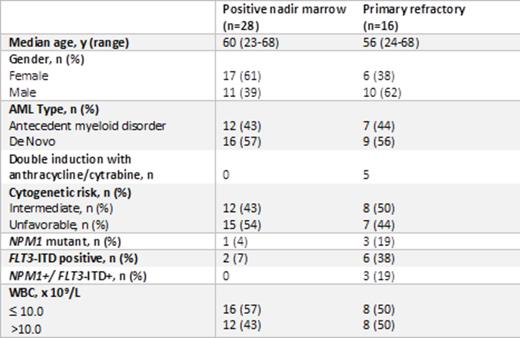Abstract
Introduction
Cytarabine in high doses (> 1 g/m2) is commonly combined with other cytotoxic chemotherapy agents to treat acute myeloid leukemia (AML) in the initial and salvage settings. Single-agent high dose cytarabine (HiDAC) is traditionally reserved for consolidation therapy for patients in remission. At our institution we also use single agent HiDAC to treat patients with active disease. We reviewed our experience to assess the outcomes.
Methods
We identified patients (pts) with AML diagnosed from 2009-2014 and treated at the Hospital of The University of Pennsylvania with anthracycline plus infusional cytarabine induction (7+3) who received subsequent single agent HiDAC for active disease. Pts included were those with evidence of residual leukemia on nadir biopsy after one cycle of therapy or those with refractory disease (positive nadir after 2 cycles of therapy or disease at the time of or within 30 days of count recovery). Comparisons of categorical covariates by subgroup were evaluated using the Fisher's exact test.
Patients
In total, 44 pts with median age of 54 (range 23-69) years were identified. Twenty-five (56%) pts had de novo AML, and 19 (43%) had AML secondary to prior myelodysplasia (MDS) or a myeloproliferative neoplasm (MPN). Twenty-two pts (50%) had unfavorable cytogenetics, 8 (18%) were FLT3 -ITD positive, and 4 (9%) were NPM1 mutant (Table 1). Indications for HiDAC salvage included positive nadir marrow or frankly progressive disease at day 14 of 1 (n=28) or refractory disease (n=16)
Outcome
Six pts (14%) died during index hospital admission for HiDAC therapy (5 from sepsis, 1 from multi-organ failure). Twelve (27%) pts achieved CR following HiDAC salvage and 4 (9%) achieved CRp. Pts with de novo AML were more likely to achieve a CR/CRp (11/24; 46%) compared to those with secondary AML (antecedent myeloid disorder or prior chemotherapy/radiation therapy) (5/20, 25%; p=0.037). CR/CRp rates were higher for pts with a white blood cell (WBC) count ≤10K/µL at initial diagnosis (50% vs. 20%; p=0.039). Pts treated for residual disease at first nadir were more likely to respond to HiDAC (n=13/28, 46%) than pts treated for refractory disease (3/16, 19%; p=0.104). Cytogenetic risk, age, presence of extramedullary disease, and FLT3 -ITD/NPM1 mutation status were not associated with response in this small sample (Table 2). No features predicted early mortality.
Conclusion
Our data suggest that pts with AML who received HiDAC therapy for active disease after 1-2 cycles of anthracycline plus infusional cytarabine induction have CR rates of 36% with single agent HiDAC with a 14% rate of early mortality. De-novo disease, initial WBC count < 10K/µL and treatment for residual disease at first nadir predict for a better response. Pts presenting with refractory disease are less likely to respond to this approach, consistent with previously published data with HiDAC combination regimens. HiDAC monotherapy for persistent AML following initial induction is a reasonable therapeutic option.
Patient Characteristics
Response to HiDAC monotherapy
Loren:Merck: Research Funding. Mangan:Incyte Corporation: Membership on an entity's Board of Directors or advisory committees. Frey:Novartis: Research Funding. Porter:Novartis: Patents & Royalties, Research Funding.
Author notes
Asterisk with author names denotes non-ASH members.



This feature is available to Subscribers Only
Sign In or Create an Account Close Modal